
LONGMONT, Colo. – Yesterday, the invasive tree pest emerald ash borer (EAB) was confirmed in the City of Longmont. This detection is still within a quarantine area established to try and prevent the human-assisted spread of EAB, but represents the first confirmation of EAB anywhere in Colorado outside the City of Boulder.
On Monday, June 6, an ash tree on private land in the vicinity of 9th Avenue and Hover Street was reported by an arborist as potentially infected with the insect. He had recognized the symptoms based on workshops and other information provided to him by the interagency Colorado EAB Response Team, which is working to manage the spread and impacts of the pest here in Colorado.
The Longmont Forestry Services department immediately provided a specimen found on the tree to the Colorado Department of Agriculture (CDA) for confirmation, and the suspect tree also was visited. Yesterday evening, the insect was confirmed by experts with the CDA and EAB Response Team as being emerald ash borer.
It is unknown whether the insect arrived in Longmont by natural spread or via accidental human transport, such as in firewood or other raw ash material.
EAB was first confirmed in Colorado in September 2013, in the City of Boulder. On November 12, 2013, the Colorado Department of Agriculture established a quarantine zone around Boulder County in an effort to protect Colorado ash trees. At this time, EAB has not been detected in Colorado outside of Boulder County or the EAB Quarantine area. However, the Colorado State Forest Service (CSFS) and other members of the EAB Response Team continue to try and detect the pest in other locations, as an estimated 15 percent or more of all urban and community trees in Colorado are ash.
“We’ve been anticipating and preparing for EAB to be found outside of Boulder since 2013,” said Dan West, CSFS entomologist. “This new detection only re-emphasizes the need for Front Range homeowners and communities to be planning now, before EAB arrives in their neighborhood.”
Many Front Range communities already have EAB management plans in place, including Longmont.
Longmont is estimated to have an ash tree population of approximately 43,000 trees. The City’s Forestry Services department manages 2,800 of those trees located in public rights-of-way, parks and other City properties. Based on the City’s Emerald Ash Borer Management Plan, Forestry Services has already been working to remove low quality ash trees throughout town and replace them with new varieties.
In 2017, the City planned to begin a protective chemical treatment regimen for about one third (approximately 900) of Longmont’s public ash trees, treating approximately 300 trees per year and continuing on a three year cycle.
Due to the confirmation of EAB in Longmont, the City is suspending its removal and replacement efforts, and all identified resources will now be put toward protective treatment. Application on the first 300 trees will take place this summer. The focus will be on high visibility areas such as Thompson Park, Collyer Park, Sunset Park and Golf Course, Twin Peaks Golf Course and areas within Downtown Longmont. Public trees identified for treatment are those that are of highest value, in good condition and larger in size.
The City will not be treating private ash trees and recommends that residents take action now to assess and evaluate treatment for their trees.
The EAB Response Team remains committed to EAB outreach and detection efforts in Longmont and surrounding areas, in addition to enforcing the quarantine. The CSFS, partnering with Boulder County and the City of Boulder, has already set more than 120 traps targeting EAB this spring to try and detect its presence along roadways outside the City of Boulder, as well as in Longmont and other areas within Boulder County. With this new confirmation of EAB in Longmont, the City will be working with the EAB Response Team to offer increased outreach efforts there this summer.
Top Five EAB tips for Longmont and Front Range Residents
- Determine now if you have any ash trees. Identifying features of ash trees include compound leaves with 5 to 9 leaflets; leaflets, buds and branches growing directly opposite from one another; and diamond-shaped bark ridges on mature trees.
- If you have an ash tree, start planning. Decide if the overall health of the tree merits treatment or if it would be best to remove and replace it with a different species. If you aren’t sure, contact a certified arborist. If pesticide treatment is the preferred option, the applicator must be licensed by the CDA as a Commercial Pesticide Applicator.
- Recognize signs of EAB infestation. Property owners with ash trees should be on the lookout for thinning of upper branches and twigs, loss of leaves, D-shaped 1/8-inch holes on the bark, vertical bark splitting or increased woodpecker activity. Report suspect trees by calling the Colorado Department of Agriculture at 1-888-248-5535 or filling out their EAB Report Form at https://www.colorado.gov/pacific/agplants/eab-identification-and-reporting.
- Be aware of EAB imposters. Other insects like lilac/ash borer, ash bark beetle and flat-headed apple tree borer may look like EAB or cause similar tree symptoms. For more information, visit www.eabcolorado.com.
- Help prevent further spread of EAB. Do not transport ash or any hardwood firewood, or any other untreated ash wood products, to other locations. Boulder County and some surrounding areas are under a federal EAB quarantine, allowing for stiff fines for those who move untreated wood from the area.
For more information about ash tree identification, the symptoms of EAB and treatment options, go www.eabcolorado.com or the Colorado State Forest Service’s Emerald Ash Borer page.

